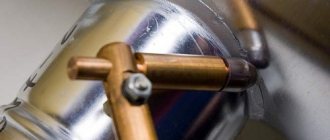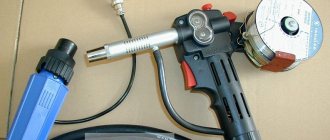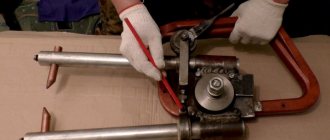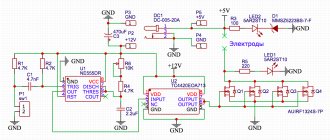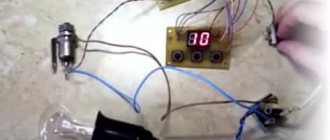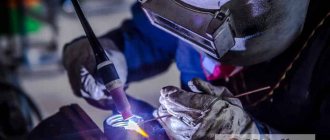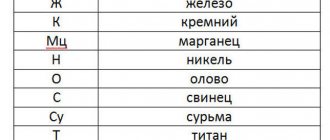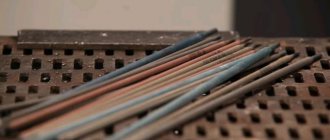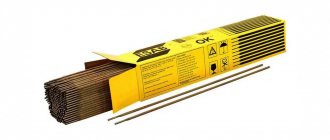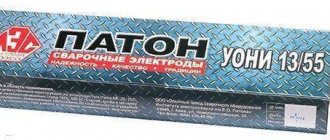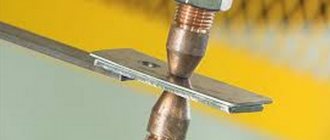Electrodes for resistance welding are designed to supply current to the elements, compress them and remove the generated heat. This part is one of the most important in the equipment, since the ability to process the unit depends on its shape. The stability of the electrode determines the level of welding quality and the duration of continuous operation. Electrodes can be shaped or straight. The production of direct type elements is regulated in the GOST 14111–77 standard.
Shaped parts are characterized by the fact that their axis is offset relative to the cone (seating surface). They are used for welding assemblies and elements of complex shapes that are difficult to reach.
Electrode material for resistance welding
The electrode material for resistance welding is selected based on the requirements determined by the specific operating conditions of the electrodes, i.e. significant heating with simultaneous compression, thermal stresses arising inside the electrode due to uneven heating, etc. The stability of the quality of welded joints depends on maintaining the shape of the working surface of the electrode in contact with the part being welded. Typically, the durability of the electrodes of point machines is assessed by the number of points welded under intensive conditions, in which the diameter of the electrode end increases to a size that requires sharpening (about 20%).
Overheating, oxidation, deformation, displacement, and melting of the electrodes during heating increase their wear. Pure copper is thermally and electrically conductive, but not heat resistant. Cold-worked copper is rarely used due to its low recrystallization temperature. Copper alloys with the addition of alloying elements are most often used. Alloying copper with chromium, beryllium, aluminum, zinc, cadmium, zirconium, magnesium, which slightly reduce electrical conductivity, increases its hardness in a heated state. Nickel, iron, and silicon are introduced into copper to strengthen the electrodes. The electrical conductivity of the alloys is estimated as a percentage compared to the conductivity of annealed copper - 0.017241 Ohm•mm 2 /m.
Alloys containing magnesium - 0.1–0.9%, cadmium 0.9–1.2%, with additions of silver 0.1% or boron 0.02% are electrically conductive. Compared to pure copper, alloys are 3–6 times more resistant, and their consumption is 6–8 times less.
Electrodes with tungsten and molybdenum inserts provide high resistance when welding galvanized steel. And electrode plates made of alloys with a hardness of 140–160HB are equipped with inserts made of a metal-ceramic alloy (40% Cu and 60% W) or Br.NBT bronze (see table).
Table. Electrode material for resistance welding : characteristics of some alloys, main purpose.
Source: weldzone.info
Error message
Resistance welding is difficult for copper and its alloys due to their high electrical and thermal conductivity, as well as the narrow temperature range over which the metal can be pressure welded. The weldability of copper alloys is better than technical copper, since they have reduced electrical and thermal conductivity. However, not all alloys weld equally well. Resistance welding is most often used for brasses and silicon bronzes. Among them, α-brass (for example, grade L68) is well welded; its electrical conductivity is no more than 28% of the electrical conductivity of copper. An increase in the zinc content in brass leads to a deterioration in its weldability due to a decrease in the ductility of the alloy. A decrease in zinc concentration adversely affects weldability, since the electrical resistance of the alloy decreases. Silicon bronze (up to 4% Si, electrical conductivity equal to approximately 10% of the electrical conductivity of copper) and copper-nickel alloys, such as cupronickel (80% Cu, 20% Ni, electrical conductivity equal to 8% of the electrical conductivity of copper) are well welded.
To obtain a clean contact surface of the workpieces, it is recommended to clean them mechanically, as well as by etching in carbon tetrachloride or caustic soda solution, followed by thorough rinsing in running water. To dissolve the oxide film, etching is used in the following mixtures: 10% sulfuric acid solution, sodium dichromate; sulfuric acid, aluminum fluoride and sodium 6d chromate.
Spot and roller welding of copper.
Spot and roller welding of copper is possible only with the use of electrodes made of refractory metals that have thermal and electrical conductivity lower than the base metal to reduce heat dissipation during welding (for example, tungsten or molybdenum). When using such electrodes, the surface of the parts becomes very hot and sometimes melts, the appearance of the product deteriorates and the electrodes quickly wear out. In this regard, spot and roller welding of technical copper is of limited suitability for industrial use.
The quality of spot welds can be improved by using heat-insulating spacers (for example, stainless steel) placed between the electrodes and the surfaces of the parts being welded, as well as by coating the contacting surfaces of the parts, for example, with silver.
For copper alloys, the use of soft modes is impractical. Typically, the heating duration of copper alloys during spot welding is limited to 0.2-0.4 s. Spot welding of brass is carried out in short pulses at high values of welding current. Due to the high electrical conductivity of brass, the thickness of the sheets welded on the same machine is taken to be approximately 2 times less than the thickness of steel sheets. Seam welding of brass requires a relatively higher specific electrode pressure than spot welding. When welding brass grade L62, υCB = 1 m/min provides a strong, tight weld. With a roller width of 3-5 mm, the welding current for brass is approximately determined from the equation
Table 1. Approximate modes of spot welding of L62 brass
Source: oitsp.ru
General principles of electrode welding of copper and its alloys
When welding copper and its alloys, the welder faces some difficulties. A crack may form at the seam. During operation, low-melting eutectics accumulate at the crystal boundaries. Pores often form. All this is important to take into account and prevent. Copper up to 4 mm thick is welded without cutting edges, up to 10 mm thick with one-sided cutting. In this case, the bevel angle of the edges should be 70 degrees, the bluntness should be 1.5-3 mm.
The fluidity of copper makes working in vertical, horizontal and ceiling positions difficult. Arc welding must be carried out at increased welding current due to the high thermal conductivity of the metal. The edges of the parts are connected with a minimum gap due to the high fluidity of copper. It is often recommended to use a steel backing.
It is better to preheat a product with a thickness of more than 6 mm to 250 degrees. In this case, it is necessary to take into account the melting characteristics of copper and its alloys. Thin metal is not heated. Welding is best done with an arc of 10-15 mm. This will make it much easier to manipulate the electrode. Copper is welded using a constant current of reverse polarity. This is important to consider. Arc welding of brass, bronze, M1-M3 must be performed with a powerful arc, increased current strength and at increased voltage . The work is done very quickly, at high speed .
If possible, welding is recommended to be done in the lower position or at an inclination angle of 20 degrees maximum relative to the vertical. The arc is directed directly to the weld pool. It is recommended to use special linings made of asbestos, flux, graphite, copper, steel. It is important to take into account all the main features and characteristics of the metal.
Reference. Copper melts at +1080 degrees, it has a specific gravity of 8.9 g/cm3, its strength is 20 kg/mm2, and its elongation is 50%.
If the product is thick , then you need to do the work gradually, fusing layers one after another . Welding in this case is performed with a reverse-step seam, the length of each section should be 20-30 cm. It is divided into two parts, 75% and 25%. First, weld the long section towards the smaller one. This reduces the risk of cracks.
The work is performed in the lower position; sometimes it is necessary to straighten the seam with a sledgehammer or hammer due to its foaming. When welding thin copper, you need to reduce the current so that burns do not occur due to heating of the part. Before starting work, it is recommended to calcinate the electrodes at a certain temperature recommended by the manufacturer.
Find out more about copper welding here. [ads-pc-3] [ads-mob-3]
Which diameter to choose
When choosing the most suitable electrode diameter, first of all you need to take into account the thickness of the copper, product, or alloy being welded. It is important to consider this and some other tips. When working with thin non-ferrous metal of large thickness, the electrode, as well as in the case of welding at high currents, will create problems and pores will appear in the seam.
Experts advise choosing this diameter: with the thickness of copper and its alloys
- 2 mm – electrode 2-3 mm thick,
- 3/3-4 mm,
- 4/4-5 mm,
- 5/5-6 mm,
- 6/ 5-7 mm,
- 7-8/6-7 mm,
- 9-10/6-8 mm.
There are electrodes for welding and surfacing with preheating up to 300-700 degrees Celsius, with low heating up to 150-350 degrees Celsius and without heating.
ELECTRODE MATERIALS FOR RESISTANCE WELDING
The material and design of the electrodes determine the quality of the welded joint, productivity, and in some cases, the possibility of conducting the resistance welding process.
It is advisable to consider the requirements for the materials of electrodes of contact machines depending on their specific purpose. For example, electrodes of point and suture machines operate at high current densities (up to 250–300 A/mm2). The material of the electrodes of this group must have high electrical and thermal conductivity, a low tendency to interact with the metal of the parts being welded, especially when welding light alloys, high hardness and a high recrystallization temperature when welding corrosion-resistant and heat-resistant alloys. The electrical conductivity of the electrodes is not lower than 70% of the electrical conductivity of pure copper with a hardness of HB 100-160 and a recrystallization temperature of 250-500 ° C. The higher the electrical conductivity and hardness of the materials being welded, the higher these indicators should be for the electrode materials (GOST 14Sh-77).
Electrodes of contact machines for butt and projection welding operate at relatively low current densities (up to 12-15 A/mm2). The materials of these electrodes are subject to reduced requirements for heat and electrical conductivity (up to 35% of the electrical conductivity of copper) and increased requirements for hardness under operating conditions (HB up to 180-200). The latter condition allows for less wear of the electrodes, more accurate alignment of workpieces during butt welding, and a more uniform distribution of forces and current during group relief welding.
For the manufacture of electrodes, cold-drawn technically pure copper is used. However, with high thermal and electrical conductivity, it has low resistance to deformation at elevated temperatures, and therefore various copper-based alloys are most widespread. Dispersion-hardening electrode alloys have the best set of properties. Cr, Cd, Zr, Mg, Zn, Ag, Co are used as alloying elements. To maintain high heat and electrical conductivity, their amount usually does not exceed 1-1.5%. To strengthen the alloys, Ni, Si, and Fe are added, and to increase the recrystallization temperature, small amounts of B, Be, Ti, and Zr are added. Copper's resistance to oxidation at 500-700°C can be increased by small additions of A1, Mg, and Be. The addition of silver and magnesium to copper helps to increase the number of welded points without darkening the surface of a product made of aluminum alloys [4]. The composition and basic properties of metals and alloys used for the manufacture of electrodes are given in table [1, 3, 4, 7, 8].
What brands of electrodes are used for copper welding
For welding, surfacing of copper and non-ferrous metals, welding of copper pipes, etc. Special copper electrodes are used for welding. Electrodes of this type include
- Komsomolets-100,
- OZB-2M,
- OZB-3,
- ANTs/OZM-2,
- ANTs/OZM-3,
- ESAB OK 94.25,
- ESAB OK 94.35,
- ESAB OK 94.55,
- ESAB OK NiCu-7 (OK 92.86),
- ESAB OK Ni-1 (OK 92.05),
- ZELLER 390.
You need to start working with them knowing some of their features and characteristics.
Komsomolets-100 is intended for surfacing and welding of copper grades M1-M3. Work should be carried out on direct current (about welding currents here), in the lower or inclined positions. Komsomolets-100 electrodes with a thickness of 3-5 millimeters are produced. Recommended current for a diameter of 3 mm is 90-180 amperes, 4 mm 120-140, 5 mm 150-190. These indicators depend on the position of the seam. Before starting work, it is recommended to heat the product to be welded to 300-700 degrees, depending on its thickness.
OZB-2M is also designed for working with bronze used in artistic casting. They can be used to fuse it onto steel and correct defects in cast iron. In this case, it is necessary to turn on the current of reverse polarity, and work in a vertical or horizontal position. OZB-2M consist of copper, iron, phosphorus, manganese, nickel and tin. Their length is 350 mm. For successful operation, it is necessary to set the welding current to the following values: for a diameter of 3 mm / 90 - 120 amperes, 4 mm / 120 - 160.
OZB-3 are used when working with non-ferrous metals, copper and bronze. They are made with a special coating (find out more about electrode coatings here). Welding should only be done in the down position. Direct current is used. The coefficient and productivity of surfacing OZB-3 is 12.5 g/Ah – 3.5 kg.h with a product diameter of 4 mm.
ANTs/OZM-2 is used to work with pure copper, and there is no need to heat it if it is not very thick. Welding should be done in an inclined or downward position. Direct current of reverse polarity is used. ANTs/OZM-2 consumes 1.6 kg to melt a kilogram of metal.
ANTs/OZM-3 are needed for working with copper products of technical grades in accordance with GOST 859-78. They are produced in thicknesses of 4-6 mm. To successfully perform welding, you need to set the current to 220-300 amperes for a diameter of 4 mm, 350-400 for 5 mm, 420-600 for 6 mm. The seam position should be down. You need to work with a short arc, with copper up to 10 mm thick, without heating, without cutting edges, using a single or double-sided seam with slight transverse vibrations of the electrode.
ESAB OK 94.25 is well suited for working with many non-ferrous metals and alloys. Especially with copper, tin bronze, burnt cast iron, brass. They can be used for surfacing steel to protect it from corrosion. It is recommended to heat thick copper products to 300 degrees. It is best to work with ESAB OK 94.25 in spatial positions 1-4.
ESAB OK 94.35 has a thick rutile coating. Used when working with products made of copper and nickel, with the latter content up to 30%. ESAB OK 94.35 electrode is used to fuse the edges. They can be used in 1-5 positions. The metal deposited with their help is endowed with excellent corrosion resistance, it is not afraid of prolonged exposure to sea salt water, and is endowed with good strength characteristics.
ESAB OK 94.55 have a basic coating type.
The electrode is good at working with bronze, red brass, and copper. Welding is usually performed with a short arc. The location of the electrode should be perpendicular to the edges. It is necessary that the weld beads are located one on top of the other. Important! The surface of each passage must not be forgotten to be cleaned of slag.
Suitable positions for work are 1-4 and 6. Tensile strength 400 MPa, hardness 120 HB. The brand ESAB OK 94.55 with a diameter of 2-4 mm is produced.
ESAB OK NiCu-7, or OK 92.86 , is used for welding copper and nickel. The metal deposited with their help is characterized as resistant to cracking, malleable, resistant to sea water, acid and alkali. Cook with this electrode in 1-4, 6 positions. This brand is produced with a thickness of 2-4 mm. The operation uses direct current of reverse polarity.
ESAB OK Ni-1 , formerly OK 92.05, has a basic coating type. To prevent the formation of cracks and pores, it is recommended to work only at currents permissible for a particular electrode diameter. Suitable for 1-4, 6 positions. The electrode is calcined for two hours at a temperature of +250 degrees. Requires direct current to operate.
ZELLER 390 has a base coating. Tensile strength 200 MPa, fluidity 185, hardness 40 HB. ZELLER 390 is available in different lengths, from 300 to 450 mm, with a diameter of 2.5-5 mm. The current strength must be set for an electrode with a thickness of 2.5 mm/80-110 amperes, 3 mm/100-130, 4 mm/130, 170 mm, 5 mm/170-200. It is used when working with products that must meet high levels of resistance to corrosion, thermal conductivity, and electrical conductivity.
[ads-pc-2] [ads-mob-2]
Electrodes for resistance welding. Characteristics of recommended alloys
Spot welding, thanks to the advent of compact hand-held machines such as BlueWeldPlus, is becoming popular not only for industrial applications, but also in everyday life. The weak point of this technology is electrodes for resistance welding: their low durability in many cases scares off the consumer.
Reasons for the fragility of resistance electric welding electrodes
The resistance welding process consists of the following stages:
- Preliminary preparation of the surface of the parts to be joined - it must not be easily cleaned of contaminants and oxides, but also very smooth in order to eliminate unevenness in the resulting electric field voltage.
- Manual or mechanical clamping of welded products - with increasing clamping force, the intensity of diffusion and the mechanical strength of the weld increase.
- Local melting of metals in the pressing zone by the heat of an electric current, resulting in the formation of a welding joint. Pressing the electrodes at this stage prevents the formation of welding spatter.
- Switching off the current and gradually cooling the weld.
Electrode materials
According to GOST 2601, the criterion for the quality of a finished seam is its tensile or shear strength. It depends on the intensity of thermal power in the electrical discharge zone, and therefore is associated primarily with the thermophysical characteristics of the electrode material.
The use of copper electrodes is ineffective for two reasons. Firstly, copper, being a highly plastic metal, does not have sufficient elasticity to completely restore the geometric shape of the electrodes during the period between operating cycles. Secondly, copper is very scarce, and frequent replacement of electrodes also causes high financial costs.
Attempts to use harder, strengthened copper are not successful: for cold-worked material, in parallel with an increase in hardness, the recrystallization temperature decreases, therefore, with each working cycle, the wear of the working end of the electrode for resistance welding will increase. Therefore, copper alloys with the addition of a number of other metals have found practical use. In particular, the introduction of cadmium, beryllium, magnesium, zinc and aluminum into a copper alloy changes the thermal conductivity slightly, but improves the hardness when heated. The resistance of the electrode to dynamic thermal loads is increased by iron, nickel, chromium and silicon.
When selecting the optimal material for welding electrodes for resistance welding, they are guided by the specific electrical conductivity of the alloy. The less it differs (downward) from the electrical conductivity of pure copper - 0.0172 Ohm mm 2 /m, the better.
The most effective resistance to wear and deformation is shown by alloys containing cadmium (0.9...1.2%), magnesium (0.1...0.9%) and boron (0.02...0.03%).
The choice of material for spot welding electrodes also depends on the specific tasks of the process. Three groups can be distinguished:
- Electrodes designed for resistance welding under harsh conditions (continuous alternation of cycles, surface temperatures up to 450…500ºС). They are made from bronzes containing chromium and zirconium (Br.Kh, Br.KhTsr 0.6-0.05. This group also includes nickel-silicon bronzes (Br.KN1-4), as well as bronzes additionally alloyed with titanium and beryllium (Br.NTB), used for spot welding of stainless and heat-resistant steels and alloys.
- Electrodes used at contact temperatures on the surface up to 250…300ºС (welding of conventional carbon and low-alloy steels, copper and aluminum products). They are made from copper alloys of the MS and MK grades.
- Electrodes for relatively light operating conditions (surface temperatures up to 120…200ºС). The materials used are cadmium bronze Br.Kd1, chromium bronze Br.X08, silicon-nickel bronze Br.NK, etc. Such electrodes can also be used for roller contact electric welding.
It should be noted that in descending order of electrical conductivity (relative to pure copper), these materials are arranged in the following sequence: Br.HTsr 0.6-0.05→MS→MK→Br.Kh→Br.Kh08→Br.NTB→Br .NK →Br.Kd1→Br.KN1-4. In particular, heating an electrode made of Br.KhTsr 0.6-0.05 bronze to the required temperature will occur approximately twice as fast as one made from Br.KN1-4 bronze.
Electrode designs
The least resistant part of the electrode is its spherical working part. The electrode is rejected if the increase in end dimensions exceeds 20% of the original dimensions. The design of the electrodes is determined by the configuration of the surface being welded. The following versions of the instrument are distinguished:
- With a cylindrical working part and a conical landing part.
- With conical landing and working parts, and a transition cylindrical section.
- With a spherical working end.
- With a beveled working end.
In addition, electrodes can be solid or composite.
When making it yourself (or re-sharpening), it is recommended to maintain the following size ratios at which the tool will have maximum durability:
- To calculate the electrode diameter d, use the dependence P = (3...4)d 2, where P is the actually necessary compression of the electrodes during the resistance electric welding process. In turn, the recommended values of upsetting pressure, at which the highest quality joints are obtained, is 2.5...4.0 kg/mm 2 of the area of the resulting weld;
- For electrodes with a conical working part, the optimal taper angle varies from 1:10 (for a tool with a working part diameter of up to 30...32 mm) to 1:5 - in the opposite case;
- The choice of cone angle is also determined by the greatest compression force: with maximum forces, it is recommended to take a taper of 1:10, as it ensures increased longitudinal resistance of the electrode.
The main forms of electrodes for resistance welding are established by GOST 14111, therefore, when using certain size ratios, you should take into account the dimensions of the mounting space for the tool for a specific model of resistance welding machine.
Significant savings in material come from the use of composite structures. At the same time, materials with high electrical conductivity values are used to manufacture the body, and the removable working part is made of alloys with high hardness and wear resistance (including thermal). In particular, metal-ceramic alloys from the Swiss company AMRCO grades A1W or A1WC, containing 56% tungsten and 44% copper, have a similar combination of properties. Their electrical conductivity reaches 60% of the electrical conductivity of pure copper, which determines low heating losses when welding. Recommended materials can also be bronze alloys with additions of chromium and zirconium, as well as tungsten.
Electrodes for resistance welding
Reading time: 5 minutes
Spot welding electrodes are completely different from classic coated stick electrodes. And resistance welding itself is significantly different from any other metal joining technology that is familiar to us.
Therefore, it is not surprising that the shape and material for resistance welding electrodes must be selected with special attention and many nuances taken into account so as not to make a mistake. In this article we will briefly describe what electrodes for resistance welding are and what they are made of.
Electrodes for spot welding
The spot welding process explains itself from its name. Accordingly, a mini welding seam is one point, the size of which is determined by the diameter of the working surface of the electrode.
Electrodes for resistance spot welding are rods made of alloys based on copper. The diameter of the working surface is determined by GOST 14111-90, and is manufactured in the range from 10-40 mm. Electrodes for spot welding are carefully selected because they have different properties. They are made with both spherical and flat working surfaces.
Curved electrode for spot welding
Electrodes for spot welding with your own hands can theoretically be made, but you need to be sure that the alloy meets the stated requirements. In addition, you need to maintain all sizes, which is not so easy at home. Therefore, when purchasing factory-made conductive elements, you can count on high-quality welding work.
Spot welding has a lot of advantages, including an aesthetic weld spot, ease of operation of the welding machine and high productivity. There is also one drawback, namely the lack of a sealed weld seam.
general information
If you have any idea about resistance welding, you have probably noticed that the electrodes used in this technology are strikingly different from the usual piece rods. For most welders, an electrode is a metal rod that has a special coating. But resistance welding uses a different type of electrode.
They are cylindrical metal products with a pointed end. Their diameter is much larger than that of a standard coated stick electrode. At the same time, electrodes for resistance welding can be of a wide variety of shapes.
Electrode shape
The most used form is straight. Such electrodes have no bends, are easy to manufacture and are used most often. Suitable for welding sheet metal and non-hard-to-reach welding. Can be made from various metals.
By the way, the electrode material should be selected based on the material of the base metal that you will be welding. Both the electrodes and the metal must have a similar composition in order for the connection to be strong and durable. This applies to electrodes of any shape and size.
But straight-shaped electrodes are not always able to form a weld point when welding is carried out in hard-to-reach places or the part is complex. In such cases, curved electrodes are used. Below you can see just a few of the possible shapes. Modern manufacturers offer dozens of varieties to perform even the most complex tasks.
To make a straight-shaped electrode, you can use inexpensive equipment that works according to a given template. But to make an electrode of complex shape, a full-size model of it is first made. This is necessary in order to eliminate errors and omissions even at the product design stage. A complex form requires increased attention and experienced specialists.
Cooling
During contact welding, electrodes are subjected to significant temperature loads. Therefore, they require rapid cooling. And there is not enough air here. Internal or external cooling with water is most often used. Water is supplied either through special tubes or directly through holes in the electrode.
Cooling electrodes with complex shapes often leads to difficulties. And all because of its special design. Therefore, when using shaped electrodes, pay special attention to their effective cooling.
If a large electrode is used (it does not matter whether it is straight or shaped), then two copper tubes can be soldered along its body and water can be released through them. Please note that resistance welding electrodes are always cooler than conventional coated piece rods. Therefore, to effectively cool them, periodically reduce the pace of welding work so that the electrodes do not overheat. This is especially true for electrodes with complex shapes.
Form
The most common form is straight. Such models are used for joining sheet metal, easily accessible processes. They do not have complex bends, they are easy to manufacture, they are made from different metals and are used more often than others.
In order for the connection to be strong, the composition of the electrodes and the base material must have a similar composition. Based on the material of the base metal, you need to select the material for the production of electrodes.
And this should be taken into account for products of any size and configuration, no matter what the composition of the base material.
In modern life, there are very difficult welding tasks. Therefore, manufacturers present many shapes and sizes.
Straight lines cannot always form a weld point because welding is often carried out in difficult conditions, hard-to-reach places or on complex parts. Therefore, there is no other choice but to use products of various intricate and curved shapes.
Electrode material
The electrode material for resistance welding cannot be absolutely anything. Resistance welding itself involves high temperatures, compression, stress, uneven heating of the electrode, etc. Accordingly, the metal from which the electrodes will be made must have characteristics that will allow the product to withstand all loads. After all, the longer the shape of the electrode remains unchanged, the better the weld spots will be. As soon as the shape begins to change under the influence of loads, the quality of the connections will immediately begin to deteriorate.
What else can cause the electrode to deform? Constant overheating, melting or even oxidation - all this awaits the electrodes used in resistance welding. Therefore, it is important to choose the right material from which they will be made.
The main material is copper. But it is never used in its pure form because it is not heat-resistant. And this is important when resistance welding. Manufacturers take this feature into account and use various copper alloys, which contain, in addition to copper, various alloying components.
This can be chromium, aluminum, zinc, magnesium, cadmium, zirconium, beryllium and some other metals. Thanks to them, copper electrodes do not lose their high electrical conductivity, while acquiring improved performance characteristics. For comparison, exclusively copper electrodes deteriorate 6 times faster than electrodes made from a mixture of copper and any alloying component.
But this does not mean that when purchasing electrodes, you can simply choose products with the composition described above and forget about the difficulties. You also need to take into account the characteristics of the metal you will be welding. So, for example, if you work with galvanized steel, then you need to purchase electrodes with copper, tungsten and molybdenum in the composition. So the electrodes will be quite hard and resistant to the base metal. And they will not fall into disrepair.
Proper Use
It is not enough to choose copper electrodes wisely; you need to understand the rules for their use. In order for the seam to meet all requirements, it is necessary to take into account the properties of copper.
Copper has the characteristic of fluidity. Immediately after the melting process begins, its solid form disappears. In addition, copper is characterized by increased thermal conductivity. Heat passes through copper much faster than through other metals, which can lead to burn-through.
It should also be taken into account that due to significantly increased activity when interacting with gases, the formation of pores and even hot cracks is possible.
That is why it is so important to set the welding mode correctly and carry out preparatory work. Before starting the welding process, the electrodes must be hardened for at least one hour. You should also prepare the parts to be welded: clean them of dirt, traces of paint and oils, and trim their edges.
When working, electrodes for soldering copper should be driven at medium speed. The formation of the seam should occur evenly to avoid burns, sagging and lack of penetration. The current strength is set 10% less than usual.
Proper use includes regular sharpening of the copper electrodes. A tool for sharpening copper electrodes is designed to clean the contact surface of the electrodes from carbon deposits.
